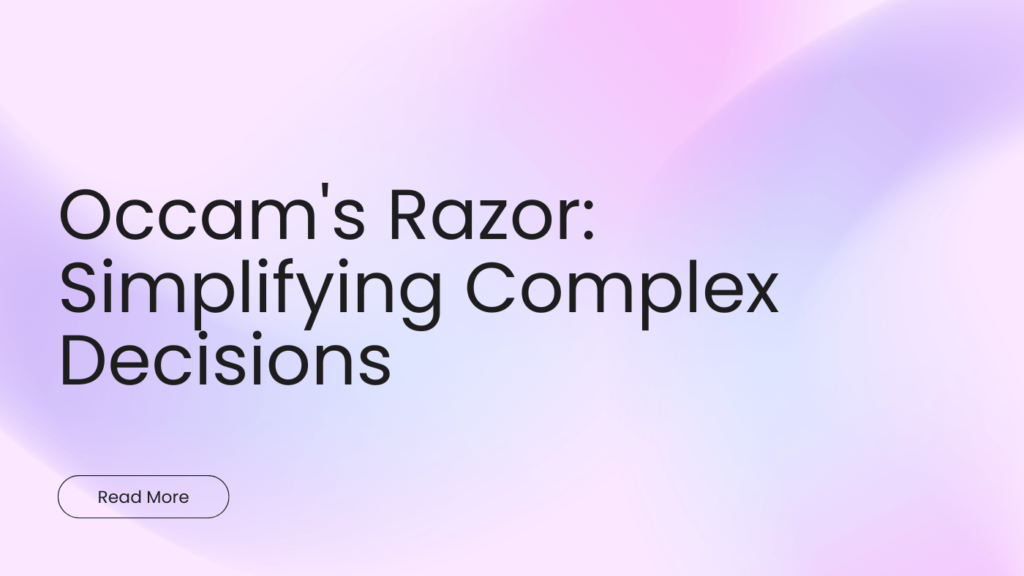Occam’s Razor: Simplifying Complex Decisions for Enhanced Clarity
In a world overflowing with information and intricate choices, the ability to make clear, effective decisions is more valuable than ever. One powerful tool to cut through the noise and find the most likely path forward is Occam’s Razor, also known as the principle of parsimony. This principle, though seemingly simple, offers a profound framework for simplifying complex decisions and enhancing mental clarity.
What is Occam’s Razor?
Occam’s Razor, named after the 14th-century English Franciscan friar and philosopher William of Ockham, is a problem-solving principle stating that among competing hypotheses, the one with the fewest assumptions should be selected. In simpler terms, the simplest explanation is usually the best. It doesn’t guarantee the “true” explanation, but it suggests a starting point for investigation and decision-making.
Essentially, when faced with multiple possible explanations for a phenomenon, Occam’s Razor encourages us to favor the one that makes the fewest assumptions. This reduces the risk of unnecessary complexity and increases the likelihood of identifying the most relevant factors at play. It helps us to avoid getting bogged down in elaborate theories that are less likely to be correct.
Why is Simplifying Decisions Important?
Our cognitive resources are limited. The human brain, while remarkably powerful, can only process so much information at once. Overloading it with complexity leads to cognitive overload, resulting in poor judgment, increased stress, and decision paralysis. Simplifying decisions is crucial for:
- Improving Accuracy: By focusing on the essential elements, we reduce the chance of being misled by irrelevant details.
- Saving Time and Energy: A simpler approach requires less investigation and analysis.
- Boosting Confidence: Understanding the core factors increases confidence in the decision made.
- Enhancing Communication: Simple explanations are easier to communicate and understand, facilitating collaboration and alignment.
How to Apply Occam’s Razor in Decision-Making
Applying Occam’s Razor isn’t about being lazy or ignoring important data. It’s about prioritising simplicity and efficiency. Here’s how to incorporate it into your decision-making process:
- Define the Problem Clearly: Start by understanding the problem you’re trying to solve. What is the desired outcome? What are the constraints?
- Generate Multiple Hypotheses: Brainstorm several possible explanations or solutions. Don’t limit yourself initially.
- Identify Assumptions: For each hypothesis, list the underlying assumptions. What needs to be true for that explanation to hold?
- Evaluate the Assumptions: Assess the validity of each assumption. How likely is it to be true? Are there simpler alternatives?
- Choose the Hypothesis with the Fewest Assumptions: Select the explanation with the fewest and most easily verifiable assumptions. This is your starting point.
- Test and Refine: Even the simplest explanation needs to be tested against reality. Gather data and refine your understanding as needed. Don’t be afraid to adjust your initial hypothesis if new evidence emerges.
Occam’s Razor as a Mental Model for Clarity
Occam’s Razor isn’t just a decision-making tool; it’s a powerful mental model that promotes clarity and efficiency in thinking. By adopting this mindset, you can:
- Avoid Overthinking: Resist the urge to create overly complex explanations. Focus on the core drivers of the problem.
- Identify Core Issues: By stripping away unnecessary layers, you can more easily identify the root cause of problems.
- Improve Problem-Solving: A simplified understanding allows for more targeted and effective solutions.
- Enhance Communication: Presenting information in a clear, concise manner improves understanding and engagement.
Examples of Occam’s Razor in Action
Here are a few examples illustrating the application of Occam’s Razor in different contexts:
- Medicine: A patient presents with symptoms of fatigue, headache, and muscle aches. Instead of immediately suspecting a rare and complex disease, a doctor might first consider common causes like the flu or a viral infection. This approach uses Occam’s Razor to prioritize the most likely and simplest explanation.
- Technology: A website is experiencing slow loading times. Instead of immediately blaming complex database issues or server problems, a developer might first check for simple issues like large image files or unoptimized code.
- Business: A company’s sales are declining. Instead of immediately implementing a complex marketing campaign, the company might first examine simpler factors like pricing, customer service, or competitor activity.
Limitations of Occam’s Razor
While a valuable tool, Occam’s Razor isn’t infallible. It’s important to be aware of its limitations:
- Simplicity Doesn’t Guarantee Truth: The simplest explanation isn’t always the correct one. Reality can be complex, and sometimes a more intricate explanation is necessary.
- Subjectivity: What one person considers “simple” may be complex to another. The principle requires careful consideration and contextual awareness.
- Bias: Our pre-existing beliefs and biases can influence our perception of simplicity. It’s crucial to maintain objectivity when applying the principle.
Conclusion: Embrace Simplicity for Clearer Decisions
In a world of increasing complexity, Occam’s Razor provides a powerful framework for simplifying decisions and enhancing mental clarity. By prioritizing the simplest explanations, we can improve accuracy, save time, boost confidence, and communicate more effectively. While not a foolproof solution, embracing simplicity as a guiding principle can lead to more informed and effective decision-making in all aspects of life. Use this mental model for clarity to cut through the noise and find the most likely path forward.


